

Bitcoin enjoyed its 13th birthday on Tuesday this week – the date the first block was mined. But bitcoin prices have hardly been celebrating, with declines of around 10% so far this year (Chart 1). The cumulative drawdown since the November highs is now at 37% (Chart 2). The total crypto market cap currently sits at $2.0tn, with bitcoin claiming a 40% dominance, so you may wonder what the reasons are, and should I buy bitcoin now?
The recent declines come as increased Fed hawkishness hits tech stocks. This suggests bitcoin is trading with broader risk sentiment rather than crypto-specific dynamics. Indeed, our on-chain and flow metrics are giving an overall neutral signal, rather than negative (see below).
The other question is, do bitcoin prices exhibit seasonality at the start of the year? Looking at bitcoin prices over January since 2014, we find five of the last eight years saw negative returns. But the last two saw positive returns (Chart 3).
What Now?
- Overall, our flow metrics are giving a neutral signal for bitcoin.
- We have three bullish signals: decreasing exchange supply, longer-term HODLers maintaining conviction to hold, and the hash rate registering new all-time highs.
- We have two bearish signals: reduced profitability of the overall coin supply and ETF outflows.
- Lastly, we have one neutral signal: little activity in futures open interest amid a constructive return to positivity for perpetual funding rates.
- With our flow metrics giving a neutral signal, we think broader risk sentiment will drive bitcoin. We would therefore wait for tech stocks to stabilise before considering long bitcoin positions.
Here is the full rundown of our metrics:

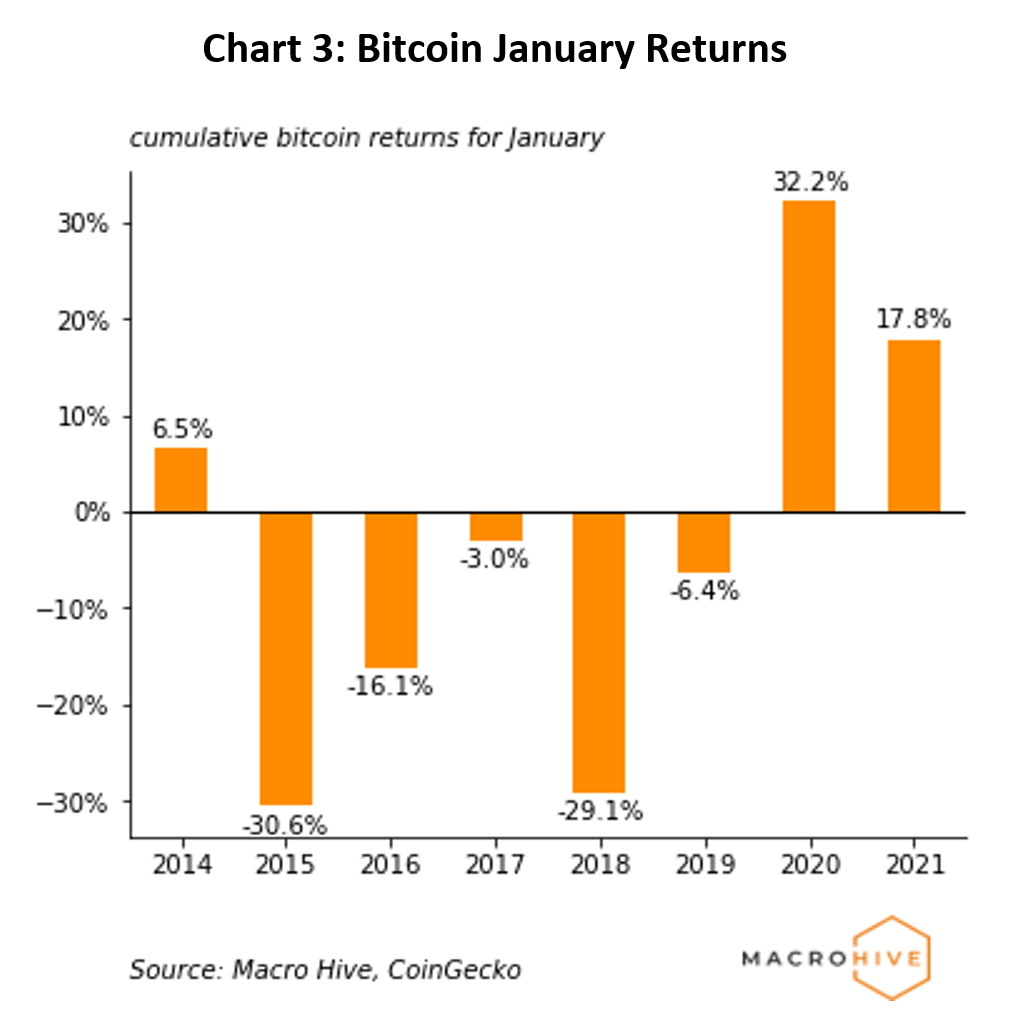
Institutional Demand: Bearish Bitcoin
Our preferred metric to track institutional demand is flows into bitcoin ETFs (Appendix). The outflows from ETFs observed during the second half of December have continued into the new year (Chart 4). This is bearish bitcoin.
However, news around bitcoin and crypto shows positive momentum. Institutional bitcoin broker, NYDIG, recently raised $1bn in a funding round, valuing the firm at over $7bn. Aave launched an institutional DeFi product. Lastly, Italian bank Banca Generali has partnered with a fintech company to add bitcoin services to its platform. This suggests that institutional flows should start to pick up.
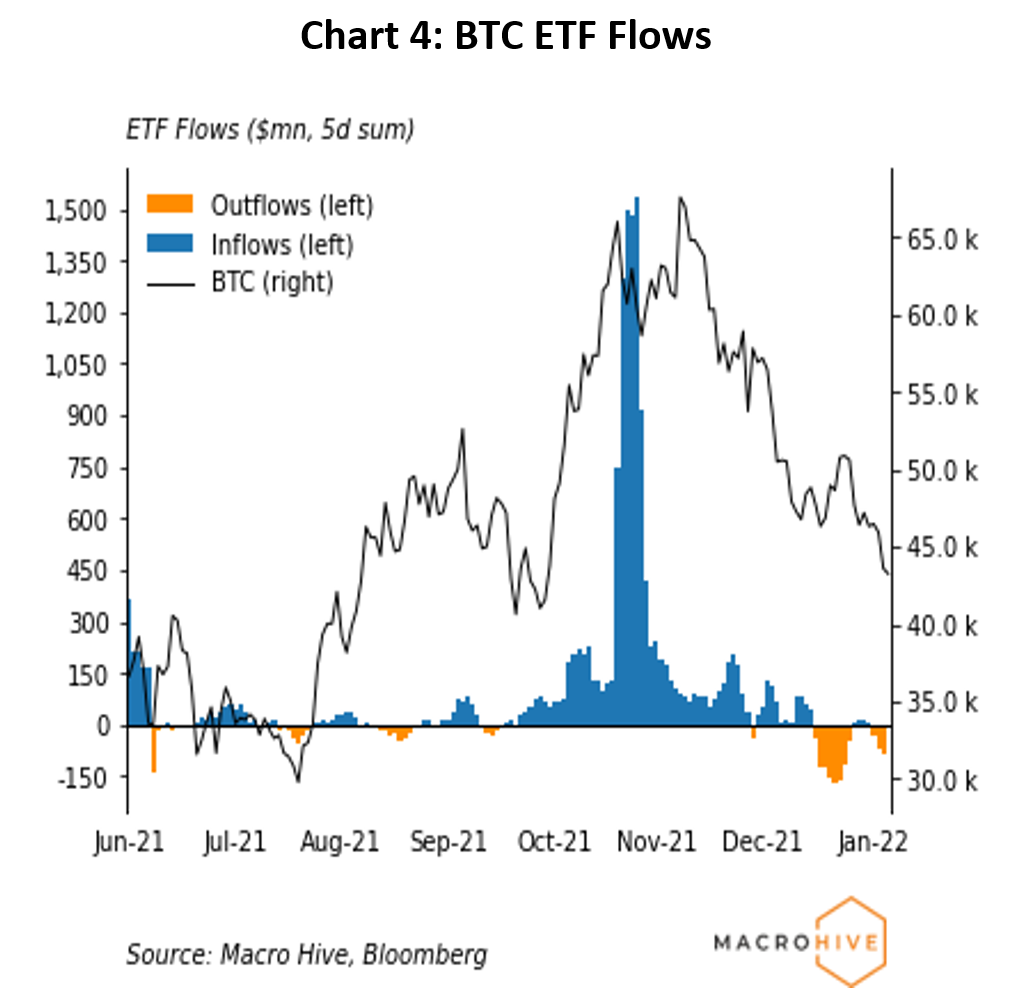
Demand for Liquidity and Exchange Activity: Bullish Bitcoin
December 2021 onwards has seen pockets of increased inflows onto exchanges. However, equally frequent pockets of outflows have offset most of these (Chart 5). On net, since the start of December, 11,654 coins left exchanges. The percentage of total bitcoin supply held on exchanges continues to decrease on average. Currently, 2.55mn coins (13.5% of the total supply) are held on exchanges (Charts 6 and 7). Outflows and the decreasing exchange balance suggest investors are still willing to hold bitcoin in cold storage – this is bullish bitcoin.
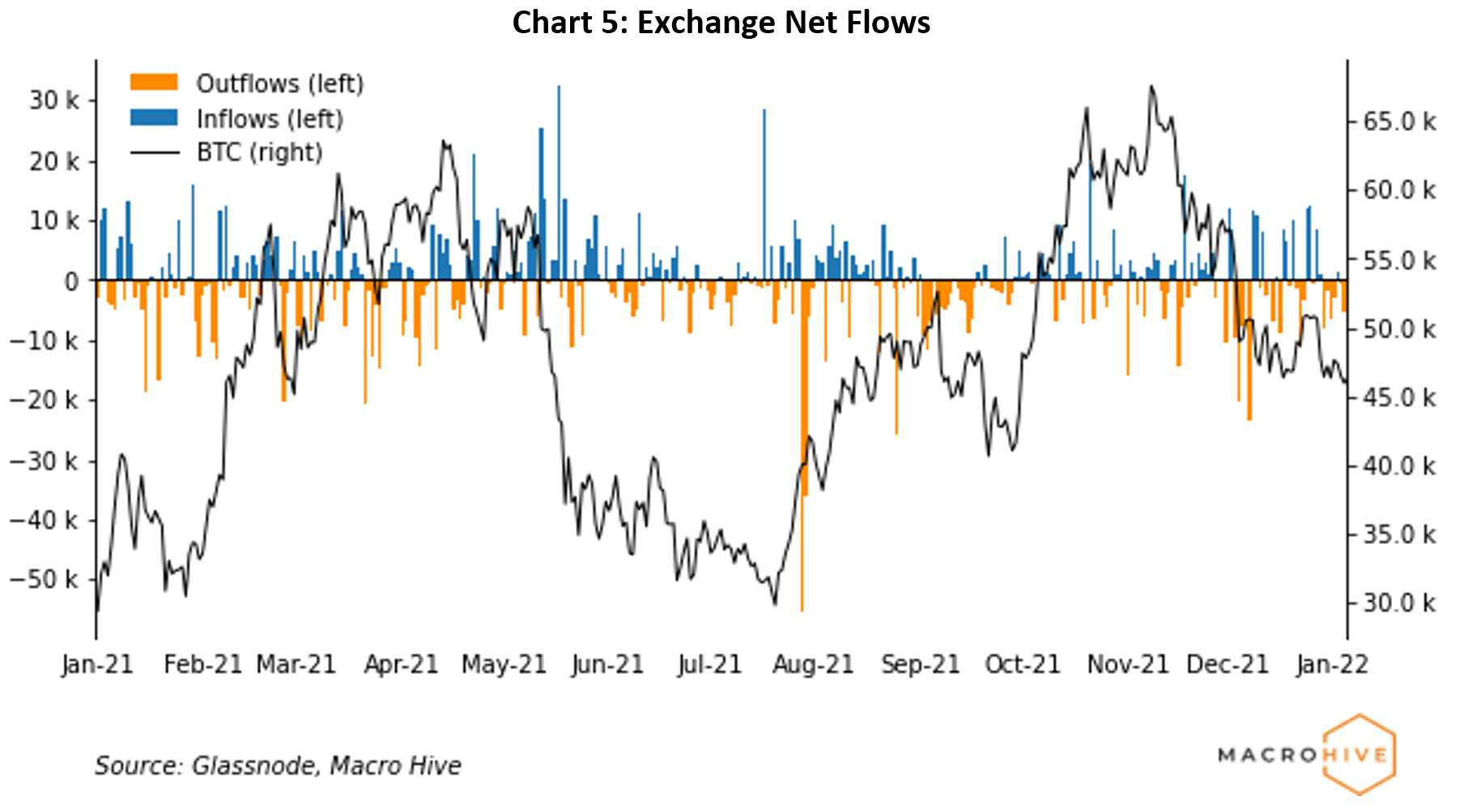
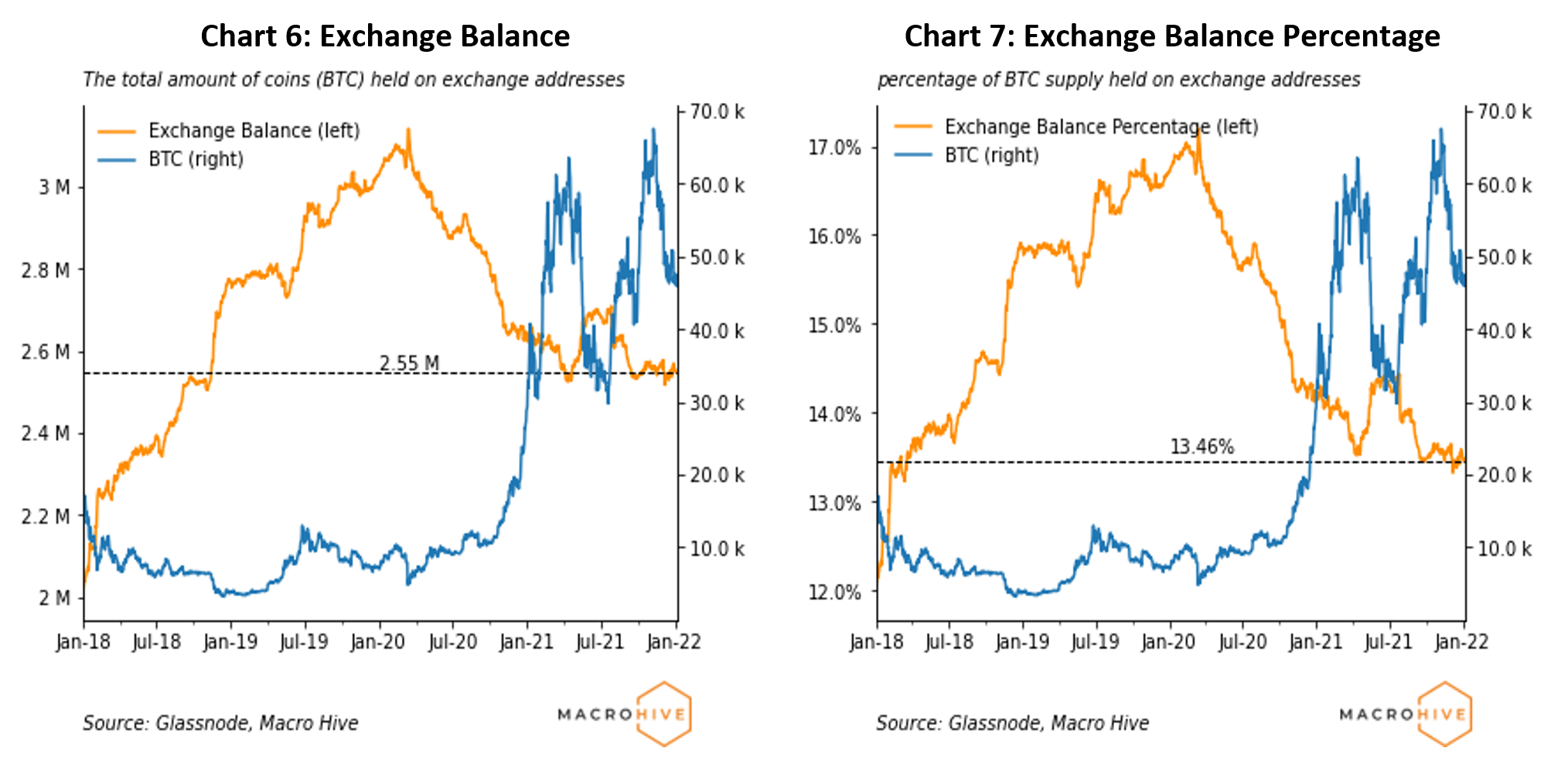
Futures Activity: Neutral Bitcoin
The flash crash in December saw huge deleveraging on futures exchanges. This flushed out a significant portion of open interest after a cascade of long liquidations. Aggregate open interest bottomed out (locally) in December, whereafter it began to recover. Yet this was short-lived, and activity has been relatively sluggish into the new year. Open interest is currently down 35% from all-time highs and up just 1% year to date (Chart 8).
Perpetual futures have no expiry date, so never settle in the traditional sense. Therefore, exchanges set funding rates to prevent a lasting divergence in the price of the futures contract and the underlying. Consequently, we can interpret funding rates as the cost of holding bitcoin via perpetual futures. Positive funding rates imply longs pay shorts and vice versa. We can use it as a proxy for trader sentiment since a positive funding rate implies traders are paying a premium to keep open long positions. Funding rates turned negative in December and have since tested that level multiple times. But they have remained positive lately, though low relative to (recent) historical levels (Chart 9). That funding rates have returned positive is constructive, but slow growth in open interest suggests some hesitation. Together, we view this as neutral for bitcoin.
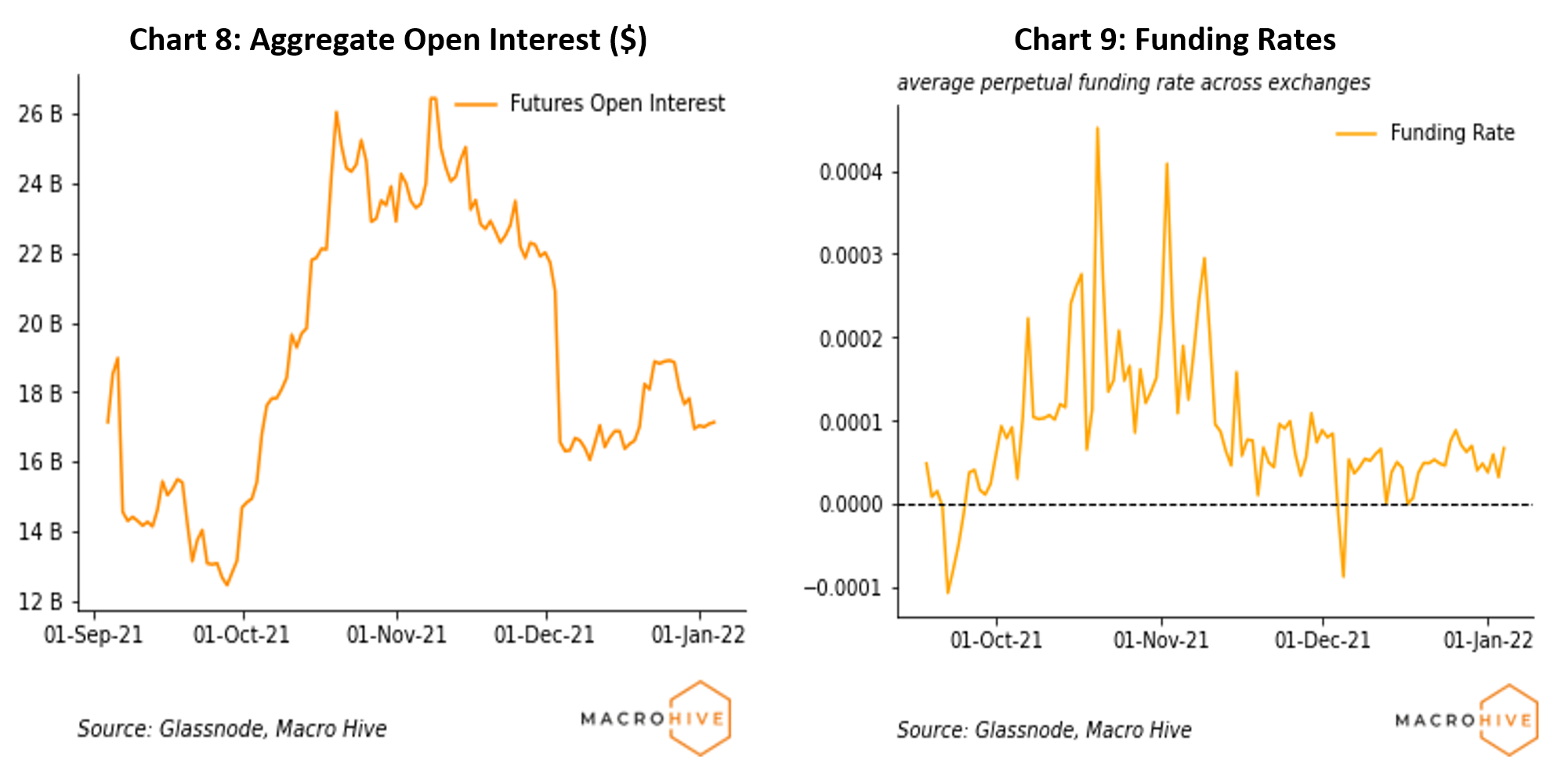
HODLers: Bullish Bitcoin
This week, we split HODLers into those that have held for greater than or equal to one year, and those for under one year (Appendix). The longer-term HODLer vintage (1y+) has been increasing since late November and more steeply in recent weeks (Chart 10). The shorter-term vintage (<1y) has displayed the opposite trend. Throughout the December correction and end-of-year profit taking, the 1y+ vintage has continued to rise, showing a somewhat surprisingly resilient conviction to hold despite the extreme volatility in recent months.
To evidence this further, we note both the coin days destroyed metric and the 1y+ revived supply metric have been falling on average (Charts 11 and 12). Overall, longer-term HODLers are maintaining their conviction to hold – this is bullish bitcoin.
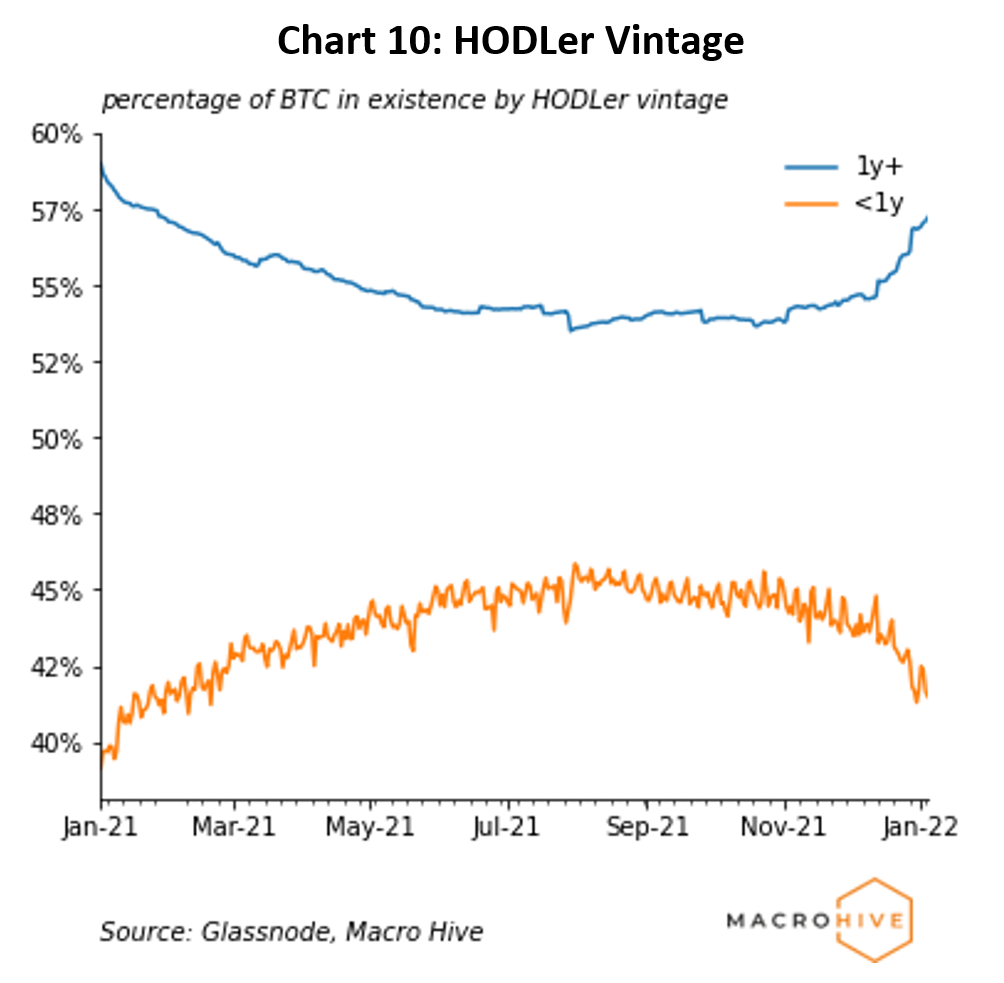
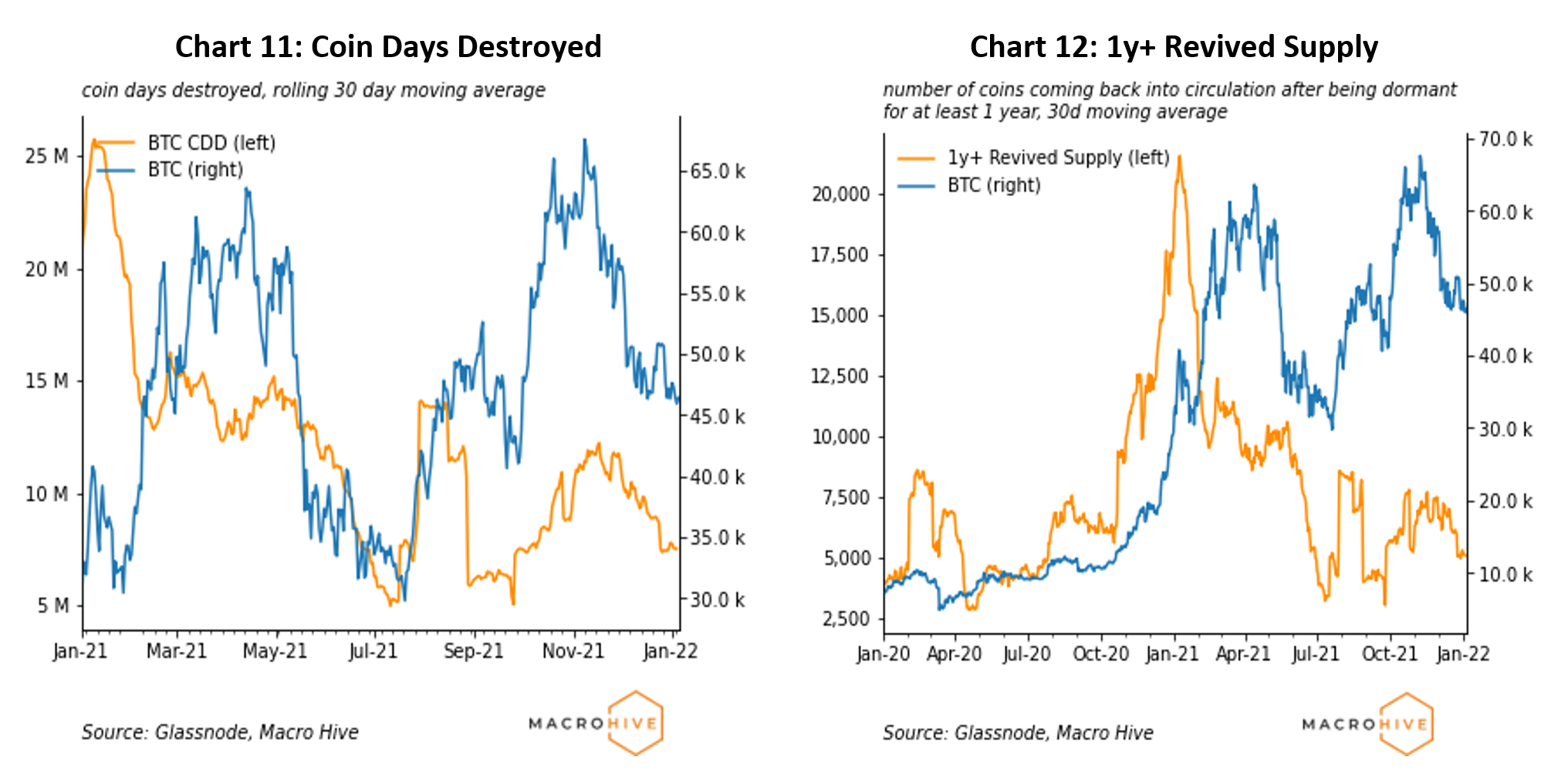
Investor Profit and Loss: Bearish Bitcoin
Public blockchains allow us to calculate three P&L-related measures: percent supply in profit (PSIP), net unrealised profit and loss (NUPL) and the spent output profit ratio (SOPR). (The Appendix details each.)
PSIP is currently 70%, down 15pp since the start of December (Chart 13). NUPL is currently 48% of market cap (Chart 14). A drop below 50% is significant as this has historically signified further downside should the value not recover – we will be watching this closely. SOPR has remained near one in recent weeks, with some dips below signifying realised losses (Chart 15). The overall profitability decrease is bearish bitcoin.
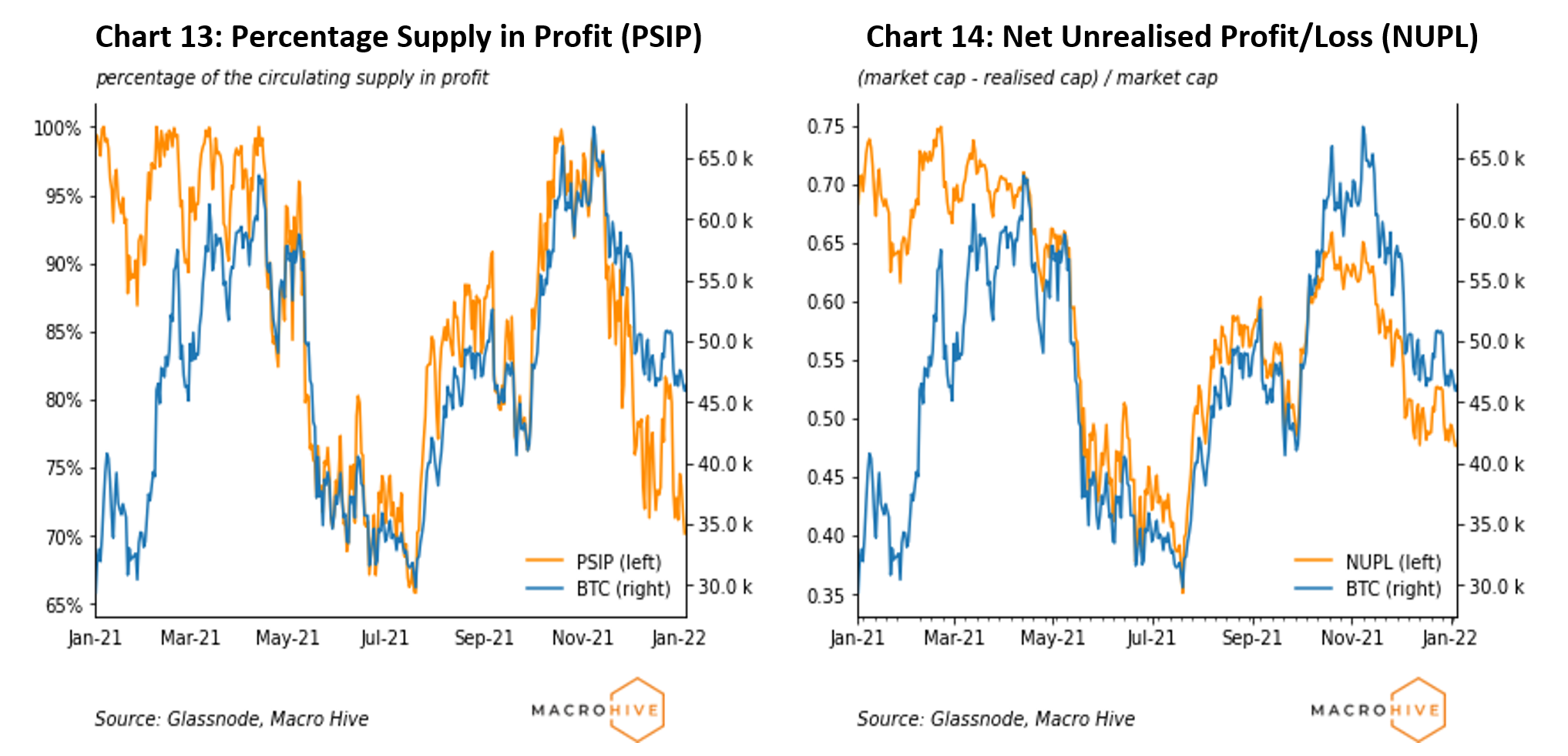
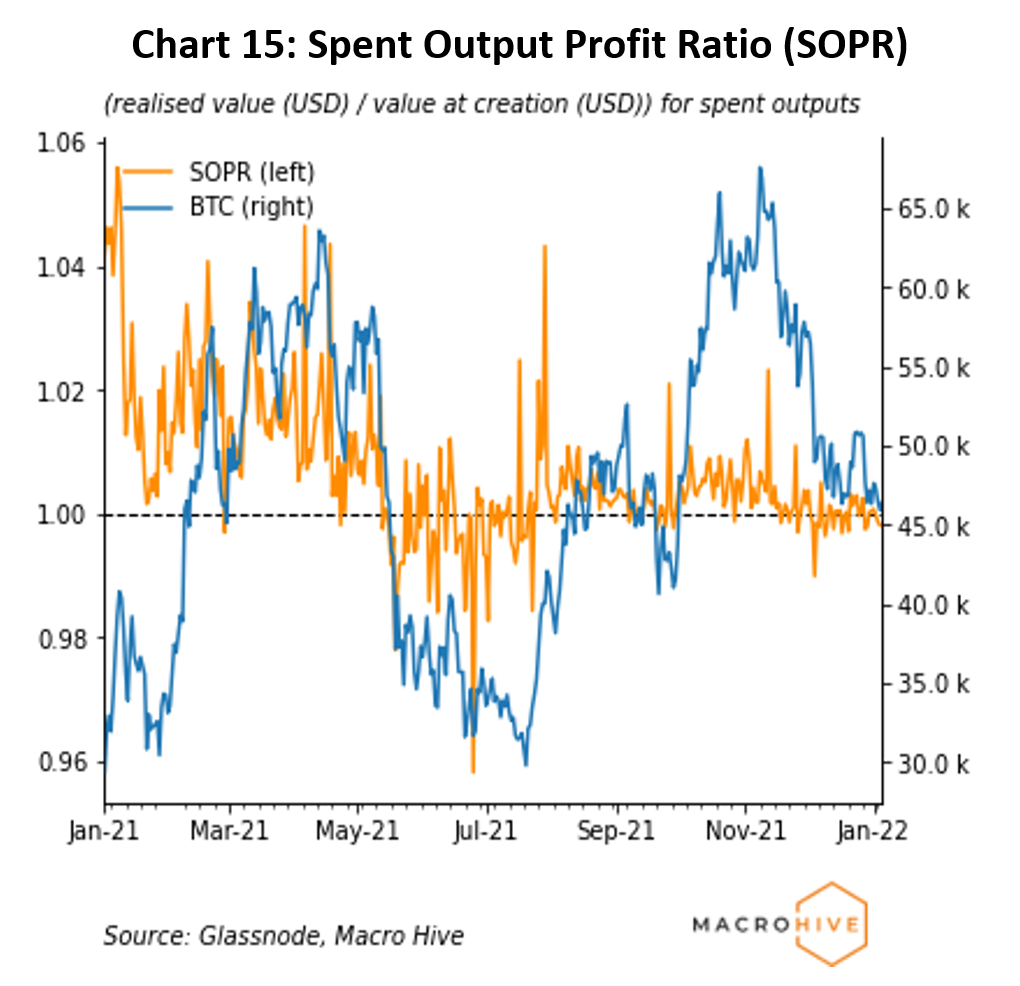
Mining Activity: Bullish Bitcoin
We track the hash rate for bitcoin. A higher rate means more computing power is available to maintain the network, deliver more security (resistance to attacks), and facilitate more transactions. We view this as a bullish sign (Appendix).
Bitcoin’s hash rate has made solid gains and recently registered new all-time highs. It is up 20% since the start of December (Chart 16). Recently, the hash rate has diverged from prices and has been gaining on average, while prices have been falling on average. Miner revenues, however, have been decreasing as prices fall (Chart 17).
Overall, the hash rate is consistently hitting new all-time highs, and we view this as bullish for bitcoin.
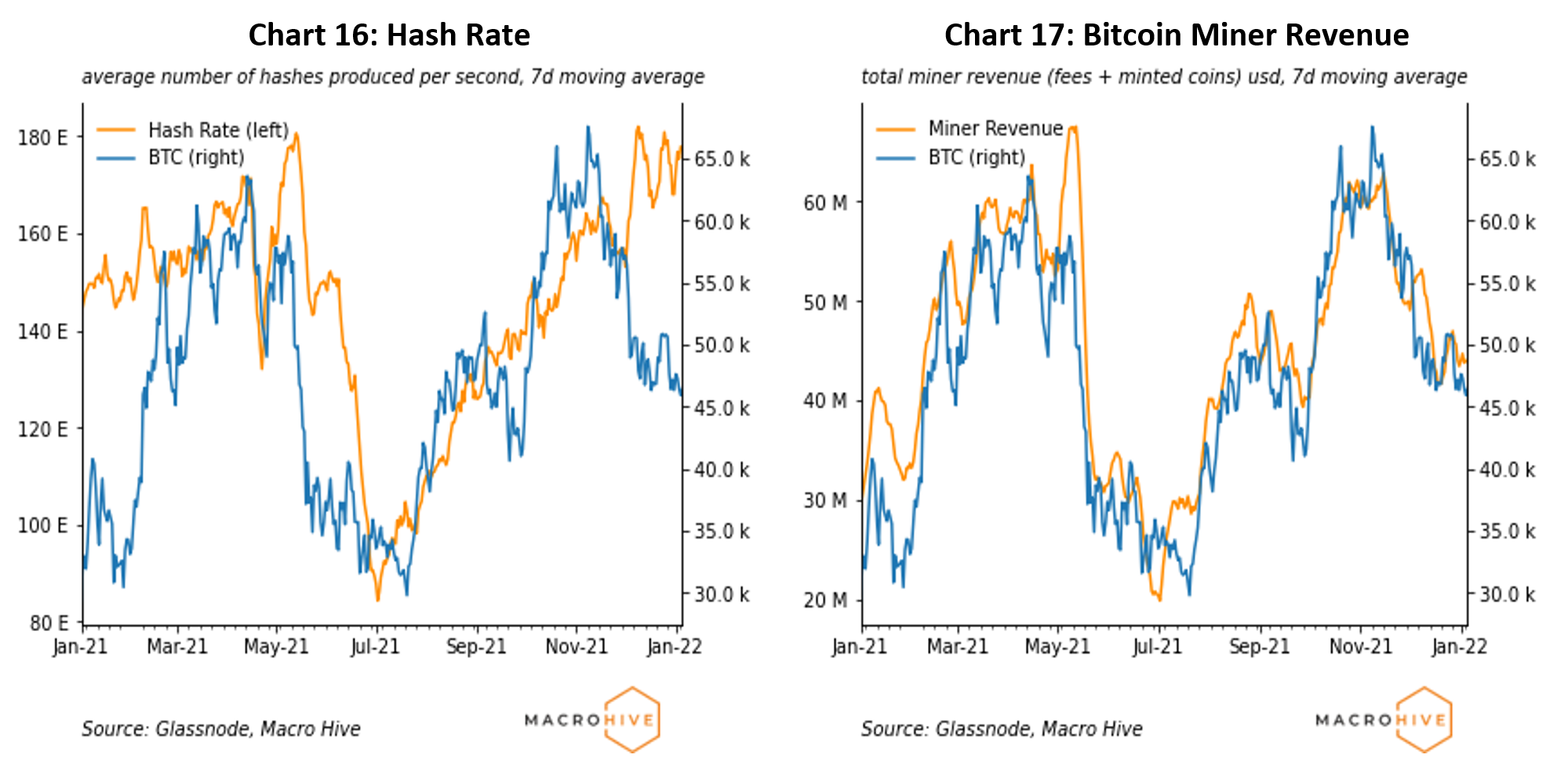
Bottom Line
We have introduced a framework for understanding the flow and microstructure dynamics of bitcoin markets. The key metrics are:
- Institutional demand: ETF outflows. Bearish bitcoin.
- Liquidity demand: outflows from exchanges/exchange supply decreasing. Bullish bitcoin.
- Futures activity: open interest sluggish and perpetual funding rates become positive. Neutral bitcoin.
- HODLer behaviour: longer-term HODLers maintain conviction to hold. Bullish bitcoin.
- P&L of investors: reduced profitability in the coin supply. Bearish bitcoin.
- Mining activity: hash rate registering new all-time highs. Bullish bitcoin.
- On balance, the metrics are neutral bitcoin in the short term.
Appendix
Institutional Demand
Perhaps the largest institutional vehicle for bitcoin is the Grayscale Bitcoin Trust, with over $27bn in assets. It invests solely in bitcoin, and so many investors, notably institutional, who cannot hold bitcoin directly can get exposure through investing in Grayscale. Consequently, if the trust trades at a premium to bitcoin prices, it may imply ‘excess’ demand from institutions, but ‘excess’ supply if it trades at a discount. Alternatively, investors may be using other vehicles to get exposure such as ETFs or holding bitcoin directly. We put more weight on ETF flows than the Grayscale premium.
Liquidity Demand
Another measure of cryptocurrency bullishness is whether investors are willing to hold it in illiquid form (e.g., a private wallet) or prefer a liquid form (e.g., on an exchange). The former would suggest investors are bullish, as they are comfortable with being unable to sell easily. Conversely, holding it in liquid form would suggest investors are bearish, as they prefer being able to sell easily.
Therefore, large flows onto crypto exchanges would suggest investors want to convert their holdings to a more liquid form, possibly implying more bearishness.
HODLers
In our introductory bitcoin flow framework, we explained ‘HODLers’ and ‘HODLing’. HODLing refers to buy-and-hold strategies in the context of bitcoin and other cryptocurrencies. Those who HODL for long periods are die-hard adherents.
We can categorise HODLers by the length of time they have held BTC. We define long-term or staunch HODLers as those who bought BTC five or more years ago and have held it ever since, medium-term HODLers as those who bought 6-12 months ago, and short-term HODLers as those who bought 3-6 months ago. We can break this down further into those who have held bitcoin from the very early days (7-10 years ago and 10+ years ago).
Profit and Loss
- The percent supply in profit (PSIP). This tracks the share of circulating BTC supply in profit. That is the percentage of circulating BTC whose current price is higher than when it was last transacted (movement).
- Net unrealized profit and loss (NUPL). This is the ratio of unrealised profits over total market capitalisation. While PSIP just focuses on whether BTC coins are in profit or not, the NUPL focuses on the size of profits. So, we could have a situation where the PSIP is low – that is, a low share of supply is in profit – but the NUPL could be high if the size of those profits is very large.
- Spent output profit ratio (SOPR). While PSIP and NUPL focus on unrealised profits or mark-to-market, this measure focuses on realised profits. SOPR is the realised value of a transaction divided by the value at initiation (or creation) – more simply, price sold divided by price paid. If SOPR is above one, investors in aggregate have realised profits, while below one means they have realised losses. In broad uptrends, SOPR spends a significant amount of time above one, whereas the opposite is true for broad downtrends.
When SOPR is rising, sellers are increasingly realising profits. The opposite is true when it is falling. A price rally with a flatter SOPR trend indicates investors are not yet realising their profits with the rally. The reluctance of investors to sell and realise a profit may be because they believe the price will increase further, which would be bullish. At the same time, more profit taking could precede a correction. Typically, buying BTC as SOPR moves around one during bullish periods has proven to be a profitable strategy.
Mining Activity
Computing power is central to the crypto market. Miners use advanced computing hardware to solve complex problems that confirm BTC (and other coin) transactions on the public ledger or blockchain. The miners are rewarded with new coins for their efforts. A measure of the complexity of the problems and so the computing performance required to solve them is the hash rate. The higher this rate, the more computing performance is needed to maintain the blockchain. The rate can fluctuate depending on demand for crypto.
Dalvir Mandara is a Quantitative Researcher at Macro Hive. Dalvir has a BSc Mathematics and Computer Science and an MSc Mathematical Finance both from the University of Birmingham. His areas of interest are in the applications of machine learning, deep learning and alternative data for predictive modelling of financial markets.
Bilal Hafeez is the CEO and Editor of Macro Hive. He spent over twenty years doing research at big banks – JPMorgan, Deutsche Bank, and Nomura, where he had various “Global Head” roles and did FX, rates and cross-markets research.
